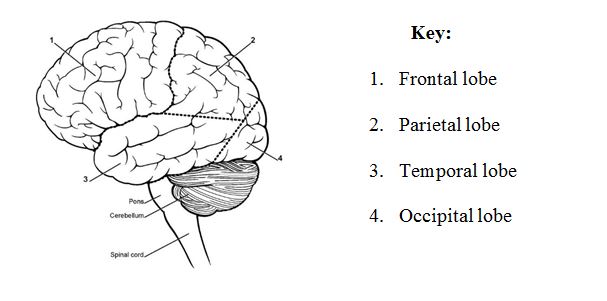Introduction
The brain is considered the most complex body organ that serves various intricate functions. Memory, thought, touch, motor skills, and breathing the main functions of the brain. The brain and the spinal cord make up the central nervous system (CNS). The organ is largely made up of fat while the other components are protein, water, salts, and carbohydrates. It is significant to note that the brain is not a muscle, but contains blood vessels and nerves. The cerebrum, the brain stem, and the cerebellum are three basic structural parts of the brain.
The Cerebrum
The cerebrum is the largest brain component which is divided into the right and left hemispheres. The two parts of the cerebrum are connected by white matter fibers called corpus callosum (Lee & Park, 2022). The frontal, parietal, temporal, and occipital lobes make up the cerebral hemispheres. The frontal and parietal lobes are distinguished posteriorly by the central sulcus. Moreover, the two lobes are inferiorly divided from the temporal lobe by the lateral sulcus. Meanwhile, the parieto-occipital sulcus distinguishes the parietal and occipital lobes (Cho et al., 2022). The cerebrum is further divided into telencephalon and diencephalon (Bhushan et al., 2022). The cortex, the subcortical fibers, and the basal nuclei make up the telencephalon, while the thalamus and hypothalamus make up the diencephalon.

The Brainstem

The brainstem is the most ancient brain part, evolutionarily, and is divided into three parts. The medulla oblongata, pons, and midbrain are the three structures that make up the brainstem (). The medulla oblongata is superior to the cervical spinal cord and continuous to it (Diek et al., 2022). The pyramids and pyramidal decussation are ventrally visualized just below the pons. The hypoglossal nerve’s rootlets can be seen as they exit the brainstem. Meanwhile, two pairs of protrusions are dorsally visible, representing the nuclei where sensory information from the dorsal columns is relayed onto thalamic projection neurons (Bhushan et al., 2022). The pons lies superior to the medulla oblongata and has a band of horizontal fibers. The midbrain, also known as mesencephalon, appears as two bundles that rostrally diverge as cerebral peduncles.
The Cerebellum

The cerebellum modulates motor control, enabling precise body movement coordination. The part occupies the posterior fossa which is dorsal to the pons and the medulla oblongata (Bhushan et al., 2022). Like the cerebrum which has gyri and sulci, the cerebellum has finer folia and fissures which increase its surface area (Lee & Park, 2022). The vermis connects the two hemispheres that make up the cerebellum. Additionally, the cerebellum has four deep nuclei that are in sequence from medial to lateral: the fastigial, globose, emboliform, and dentate (Bhushan et al., 2022). Brain tumors in children are commonly located at the cerebellum. Meanwhile, in adults, they are formed around the posterior fossa.
Conclusion
The brain is made up of the cerebellum, brainstem, and cerebrum. The three parts of the brain serve different functions that help in thought processing, movements, touch, motor skills, and other body regulation functions. The cerebrum is the largest brain component and consists of the frontal, parietal, occipital, and temporal lobes. Meanwhile, the brainstem is the most ancient brain part according to evolutionary studies. The cerebellum occupies the posterior fossa and is responsible for motor control modulation.
References
Bhushan, R., Ravichandiran, V., & Kumar, N. (2022). An overview of the anatomy and physiology of the brain. Nanocarriers for Drug-Targeting Brain Tumors, 3–29.
Cho, E. B., Kim, D., Jeong, B., Shin, J. H., Chung, Y. H., Kim, S. T., Kim, B. J., Han, C. E., & Min, J.-H. (2022). Disrupted structural network of inferomedial temporal regions in relapsing–remitting multiple sclerosis compared with neuromyelitis optica spectrum disorder. Scientific Reports, 12(1), 5152.
Diek, D., Smidt, M. P., & Mesman, S. (2022). Molecular organization and patterning of the medulla oblongata in health and disease. International Journal of Molecular Sciences, 23(16), 9260.
Lee, D., & Park, H.-J. (2022). A populational connection distribution map for the whole brain white matter reveals ordered cortical wiring in the space of white matter. NeuroImage, 254, 119167.
Quan, P., He, L., Mao, T., Fang, Z., Deng, Y., Pan, Y., Zhang, X., Zhao, K., Lei, H., Detre, J. A., Kable, J. W., & Rao, H. (2022). Cerebellum anatomy predicts individual risk-taking behavior and risk tolerance. NeuroImage, 254, 119148.
The University of Queensland (2018). The midbrain. Web.